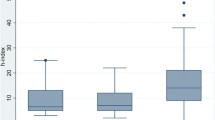Abstract
Leaders of academic institutions evaluate academic productivity when deciding to hire, promote, or award resources. This study examined the distribution of the h-index, an assessment of academic standing, among radiation oncologists. The authors collected h-indices for 826 US academic radiation oncologists from a commercial bibliographic database (SCOPUS, Elsevier B.V., NL). Then, logarithmic transformation was performed on h-indices and ranked h-indices, and results were compared to estimates of a power law distribution. The h-index frequency distribution conformed to both the log-linear variation of a power law (r 2 = .99) and the beta distribution with the same fitting exponents as previously described in a power law analysis of the productivity of neurosurgeons. Within radiation oncology, as in neurosurgery, there are exceedingly more faculty with an h-index of 1–2. The distribution fitting the same variation of a power law within two fields suggests applicability to other areas of academia.

Similar content being viewed by others
References
Hirsch JE (2005) An index to quantify an individual’s scientific research output. Proc Natl Acad Sci 102(46):16569–16572
Choi M, Fuller CD, Thomas CR Jr (2009) Estimation of citation-based scholarly activity among radiation oncology faculty at domestic residency-training institutions: 1997–2007. Int J Radiat Oncol Biol Phys 74(1):172–178
Lee J, Kraus KL, Couldwell WT (2009) Use of the h index in neurosurgery. J Neurosurg 111(2):387–392
Rad AE, Brinjikji W, Cloft HJ, Kallmes DF (2010) The H-index in academic radiology. Acad Radiol 17(7):817–821
Poynard T, Thabut D, Jabre P et al (2011) Ranking hepatologists: which Hirsch’s h-index to prevent the “e-crise de foi-e”? Clin Res Hepatol Gastroenterol 35(5):375–386
Mullins ME (2010) Has the time come for bibliometrics and the h-index in academic radiology? Acad Radiol 17(7):815–816
Kulasegarah J, Fenton JE (2010) Comparison of the h index with standard bibliometric indicators to rank influential otolaryngologists in Europe and North America. Eur Arch Otorhinolaryngol 267(3):455–458
Hunt GE, Cleary M, Walter G (2010) Psychiatry and the Hirsch h-index: the relationship between journal impact factors and accrued citations. Harv Rev Psychiatry 18(4):207–219
Healy NA, Glynn RW, Scutaru C, Groneberg D, Kerin MJ, Sweeney KJ (2011) The h index and the identification of global benchmarks for breast cancer research output. Breast Cancer Res Treat 127(3):845–851
Benway BM, Kalidas P, Cabello JM, Bhayani SB (2009) Does citation analysis reveal association between h-index and academic rank in urology? Urology 74(1):30–33
Baldock C (2008) The h-index and medical physics. Australas Phys Eng Sci Med 31(2):xi–xii
Spearman CM, Quigley MJ, Quigley MR, Wilberger JE (2010) Survey of the h index for all of academic neurosurgery: another power-law phenomenon? J Neurosurg 113(5):929–933
Mansilla RKE, Cocho G, Miramontes P (2007) On the behavior of journal impact factor rank-order distribution. J Informetrics 1(2):155–160
Martinez-Mekler G, Alvarez Martinez R, Beltran del Rio M, Mansilla R, Miramontes P, Cocho G (2009) Universality of rank-ordering distributions in the arts and sciences. PLoS One 4(3):e4791
Kelly CD, Jennions MD (2006) The h index and career assessment by numbers. Trends Ecol Evol 21(4):167–170
Bornmann L, Daniel HD (2009) The state of h index research. Is the h index the ideal way to measure research performance? EMBO Rep 10(1):2–6
Bartneck C, Kokkelmans S (2011) Detecting h-index manipulation through self-citation analysis. Scientometrics 87(1):85–98
Butson MJ, Yu PK (2010) The first author h-index (h(fa)-index): levelling the field for small and large institute medical and science scholars. Australas Phys Eng Sci Med 33(4):299–300
Egghe L (2006) Theory and practise of the g-index. Scientometrics 69(131):1–31
Zhang CT (2009) The e-index, complementing the h-index for excess citations. PLoS One 4(5):e5429
Author information
Authors and Affiliations
Corresponding author
Rights and permissions
About this article
Cite this article
Quigley, M.R., Holliday, E.B., Fuller, C.D. et al. Distribution of the h-Index in Radiation Oncology Conforms to a Variation of Power Law: Implications for Assessing Academic Productivity. J Canc Educ 27, 463–466 (2012). https://doi.org/10.1007/s13187-012-0363-y
Published:
Issue Date:
DOI: https://doi.org/10.1007/s13187-012-0363-y




